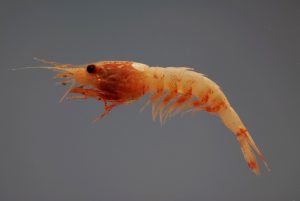Study Evaluates Short-Term Oil Toxicity in Deep-Sea Crustaceans
– JUNE 26, 2018
Researchers conducted 48-hour toxicity experiments on deep ocean crustaceans (200 – 1000 m depth) to determine the impact threshold levels for one polycyclic aromatic hydrocarbon (PAH, 1-methylnaphthalene) under various environmental conditions. Compared to other organisms for which similar toxicity data are available, the concentrations inside the tested crustaceans at time of death suggest higher sensitivity than previously studied organisms, including other crustaceans. Temperature changes had a larger impact on the partitioning coefficient (one of the most important parameters for estimating adsorption of contaminants) of 1-methylnaphthalene than salinity changes. The researchers published their findings in Environmental Toxicology and Chemistry: Short‐term toxicity of 1‐methylnaphthalene to Americamysis bahia and 5 deep‐sea crustaceans.
Micronekton (small organisms that actively swim) and plankton (small organisms that drift) migrate vertically through the water column and are a major trophic link between deep- and shallow-water ecosystems. These animals are involved in one of the largest animal migrations on earth, migrating on a nightly basis and forming massive sonic scattering layers picked up byshipboard sonars.
“These are deep sea animals which people know exist, but probably have never seen, and they are a key part of the ocean’s food web. A negative impact on their population could have a cascading effect on the ocean ecosystem,” said study author Anthony Knap. “Evidence suggests that these deep-sea crustaceans, which are a food source for commercial fishes like tuna, could have been adversely impacted during the Deepwater Horizon spill.” The study noted that because of their migratory behavior, these animals could carry contaminants from the deep ocean, such as those found in the subsurface oil plume, to surface waters.
The authors said that previous oil toxicity studies on micronekton and zooplankton focused primarily on animals living at 0 – 200 m depth, but they are unaware of publications about median lethal concentrations (LC50, the concentration at which 50% of test subjects experience mortality) of PAHs for deep-sea species. The team used commercially obtained mysid shrimp (Americamysis bahia) and deep-sea crustaceans (Janicella spinacauda, Systellaspis debilis, Sergestes sp., Sergia sp., and a euphasiid species) collected in the Florida Straights (150 – 600 m depth).
The team collected the organism with a sophisticated net system and kept them alive in special refrigerated containers to the laboratory. A continuous-exposure flow system and passive dosing toxicity testing protocol for various concentrations of 1-methylnaphthalene, a single hydrocarbon compound often used in toxicological studies to establish toxic threshold concentrations: 200, 400, 800, 1600, and 3200 µg/L for mysid shrimp and 300, 600, 1200, and 2400 µg/L for deep-sea crustaceans. The authors have been working with colleagues at Exxon-Mobil using these methods, which are industry standards.
Knap said that concentrations of 1-methylnaphthalene used in this study cannot be compared with oil concentrations found during Deepwater Horizon because oil is composed of thousands of such single hydrocarbons. “This paper tried to establish LC50 and Critical Lipid Body Burden (CBB) on deep-sea organisms because mortality data against oil or single hydrocarbons are extremely limited. The question was where did these organisms fit on a set of effects for many other marine and freshwater organisms which have data on LC50’s.” Future experiments will use oil and chemically dispersed oil.
Data are publicly available through the Gulf of Mexico Research Initiative Information & Data Cooperative (GRIIDC) at doi:10.7266/N7WS8RN2, doi:10.7266/N7S46QBC, and doi:10.7266/N7PR7TB8.
The study’s authors are Anthony Knap, Nicholas R. Turner, Gopal Bera, D. Abigail Renegar, Tamara Frank, Jose Sericano, and Bernhard M. Riegl.
************
This research was made possible in part by a grant from the Gulf of Mexico Research Initiative (GoMRI) to the Texas A&M University Geochemical and Environmental Research Group and the Nova Southeastern University Halmos College of Natural Sciences and Oceanography for their project Deep-sea Risk Assessment and species sensitivity to WAF, CEWAF and Dispersant.
The Gulf of Mexico Research Initiative (GoMRI) is a 10-year independent research program established to study the effect, and the potential associated impact, of hydrocarbon releases on the environment and public health, as well as to develop improved spill mitigation, oil detection, characterization and remediation technologies. An independent and academic 20-member Research Board makes the funding and research direction decisions to ensure the intellectual quality, effectiveness and academic independence of the GoMRI research. All research data, findings and publications will be made publicly available. The program was established through a $500 million financial commitment from BP. For more information, visit https://gulfresearchinitiative.org/.
© Copyright 2010-2018 Gulf of Mexico Research Initiative (GoMRI) – All Rights Reserved. Redistribution is encouraged with acknowledgement to the Gulf of Mexico Research Initiative (GoMRI). Please credit images and/or videos as done in each article. Questions? Contact web-content editor Nilde “Maggie” Dannreuther, Northern Gulf Institute, Mississippi State University (maggied@ngi.msstate.edu).






